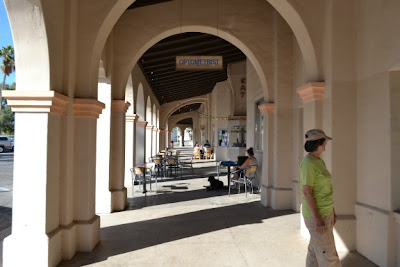Rain in the making!
If I am to believe what the weather forecast predicts, we are going to have rain or at least rain showers for the next 10 days. Arrgh!
Does that mean I will sit more with the laptop and write stories for the readers around the world? Maybe! It is just that it seems I have hit a dry hole, nothing comes to mind.
I have been thinking of starting a guide service on the "Beloved Island". That idea could be a result of being laid up with my left leg and having nothing else to do. When Bea sees me in such deep thoughts she always asks me, "What are you pondering about?"
Well, tell you what, I can show you a couple of pics from Ajo, Arizona. We were visiting the Ajo area before this blog was started. Ajo used to be a mining town with a population of 7000 at it's peak, but the decline of the industry brought Ajo's population down to well 3000.
Ajo is the Spanish word for garlic (Spanish pronunciation: [ˈaxo]). The Spanish aple may have named the place using the familiar word in place of the similar-sounding O'odham word for paint (oʼoho). The Tohono O'odham people obtained red paint pigments from the area.
Native Americans, Spaniards and Americans have all extracted mineral wealth from Ajo's abundant ore deposits. In the early nineteenth century, there was a Spanish minenicknamed "Old Bat Hole" that was abandoned due to Indian raids. The first Anglo to pass through the Ajo area, Tom Childs, Sr., found the deserted mine complete with a 60-foot (18 m) shaft, mesquite ladders, and rawhide buckets in 1847. He did not stay long at that time, because he was on his way to the silver mines near Magdalena de Kino, Sonora.
Three and a half decades later, Childs and his son returned with a friend and started developing the abandoned mine.
In the year 1884, the camp at Ajo was practically abandoned. Not a soul was in camp when Tom Childs Sr., and his son arrived. With them was Washington Michael Jacobs of Tucson, Arizona...Childs and Jacobs located the mining claim which constituted most of the old Ajo group of mines. They made a permanent camp and worked the mines... - The Ancient Mines of Ajo by Dan Rose
High-grade native copper made Ajo the first copper mine in Arizona. Soon the Arizona Mining & Trading company, formed by Peter M. Brady, a friend of Childs, worked the rich surface ores, shipping loads around Cape Horn for smelting in Swansea, Wales, in the mid 1880s. The mine closed when a ship sank off the coast of Patagonia. Long supply lines and the lack of water discouraged large mining companies
With the advent of new recovery methods for low-grade ore, Ajo boomed. In 1911, Col. John Campbell Greenway, a Rough Rider, bought the New Cornelia mine from John Boddie. He became general manager of the Calumet and the Arizona mining company and expanded it on a grand scale. The Tucson, Cornelia & Gila Bend Railroad was built from Gila Bend to serve the mining industry and was in service from 1916 to 1985. In 1921, Phelps Dodge, the nation's largest copper company, bought New Cornelia and the mine became the New Cornelia Branch of Phelps Dodge, managed by Michael Curley. For several decades more than 1,000 men worked for Phelps Dodge in the open pit mine. The mine closed in 1985, following a bitter strike and a depressed copper market. Ajo is now home to many retired people, to Border Patrol agents, and young families.
 |
| along the Central Ajo Plaza |
 |
| AJO Conception Church |
 |
| The former Railroad Station at the lower end of the Ajo Plaza |



No comments:
Post a Comment
We like to hear from you. You can add your comment here: